Analyzing Blood Sugar Testing Competency Using Gibb’s Reflective Cycle
VerifiedAdded on 2023/06/05
|8
|1134
|449
Essay
AI Summary
This essay provides a reflective analysis of blood sugar testing skills using Gibb's cycle, a model for reflective writing that includes description, feelings, evaluation, analysis, and conclusion. The author discusses the importance of blood sugar testing for diagnosing diabetes and monitoring blood glucose levels, particularly in high-risk individuals such as pregnant women and unconscious patients. The essay explores the author's feelings about the procedure, its advantages and disadvantages, and the psychological preparation required for patients. It also emphasizes the role of medical practitioners in understanding different types of blood sugar tests, their purposes, and potential complications, highlighting the importance of glucagon and insulin in regulating blood sugar levels. The author concludes that blood sugar testing is a crucial clinical skill and emphasizes the need to understand associated complications and relevant patient history.
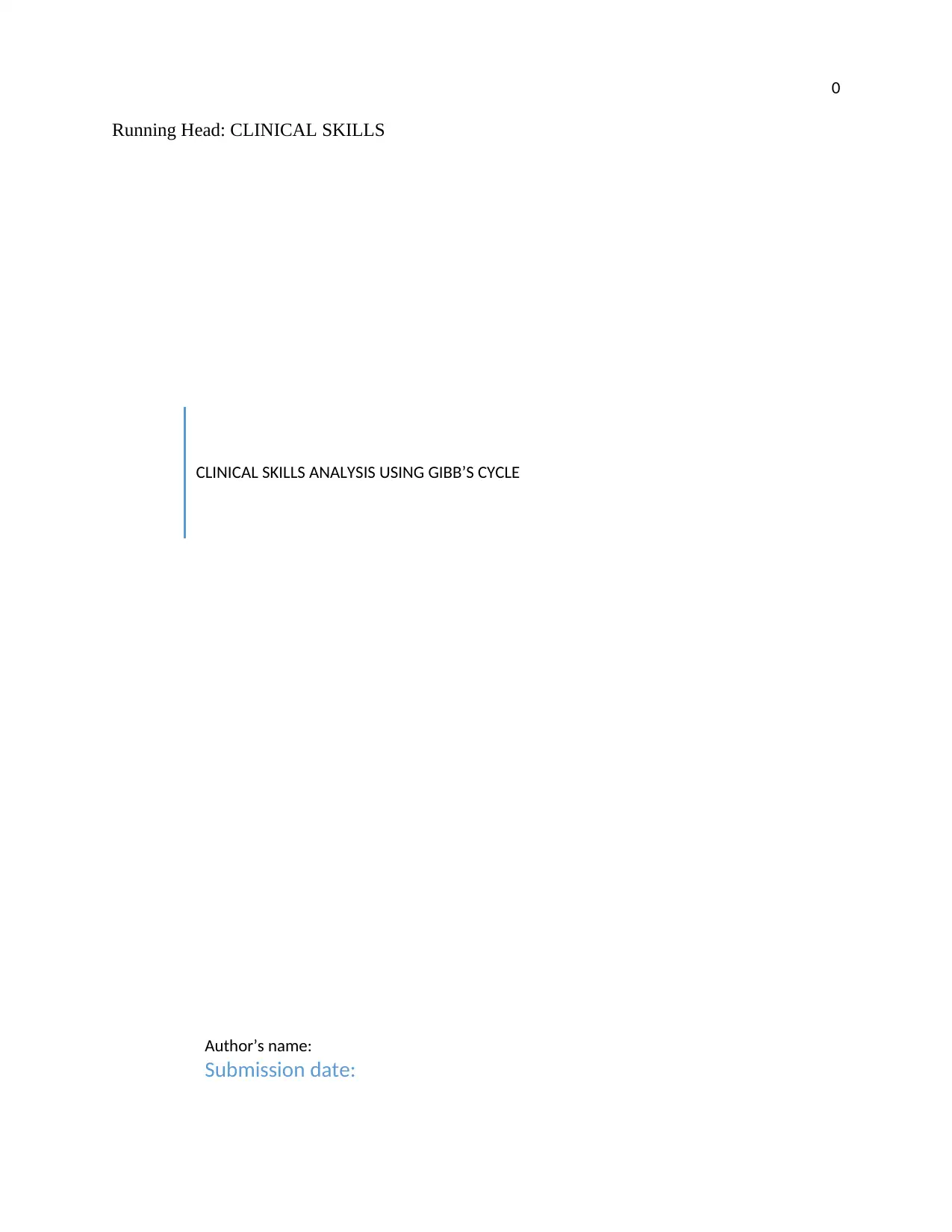
0
Running Head: CLINICAL SKILLS
CLINICAL SKILLS ANALYSIS USING GIBB’S CYCLE
Author’s name:
Submission date:
Running Head: CLINICAL SKILLS
CLINICAL SKILLS ANALYSIS USING GIBB’S CYCLE
Author’s name:
Submission date:
Paraphrase This Document
Need a fresh take? Get an instant paraphrase of this document with our AI Paraphraser
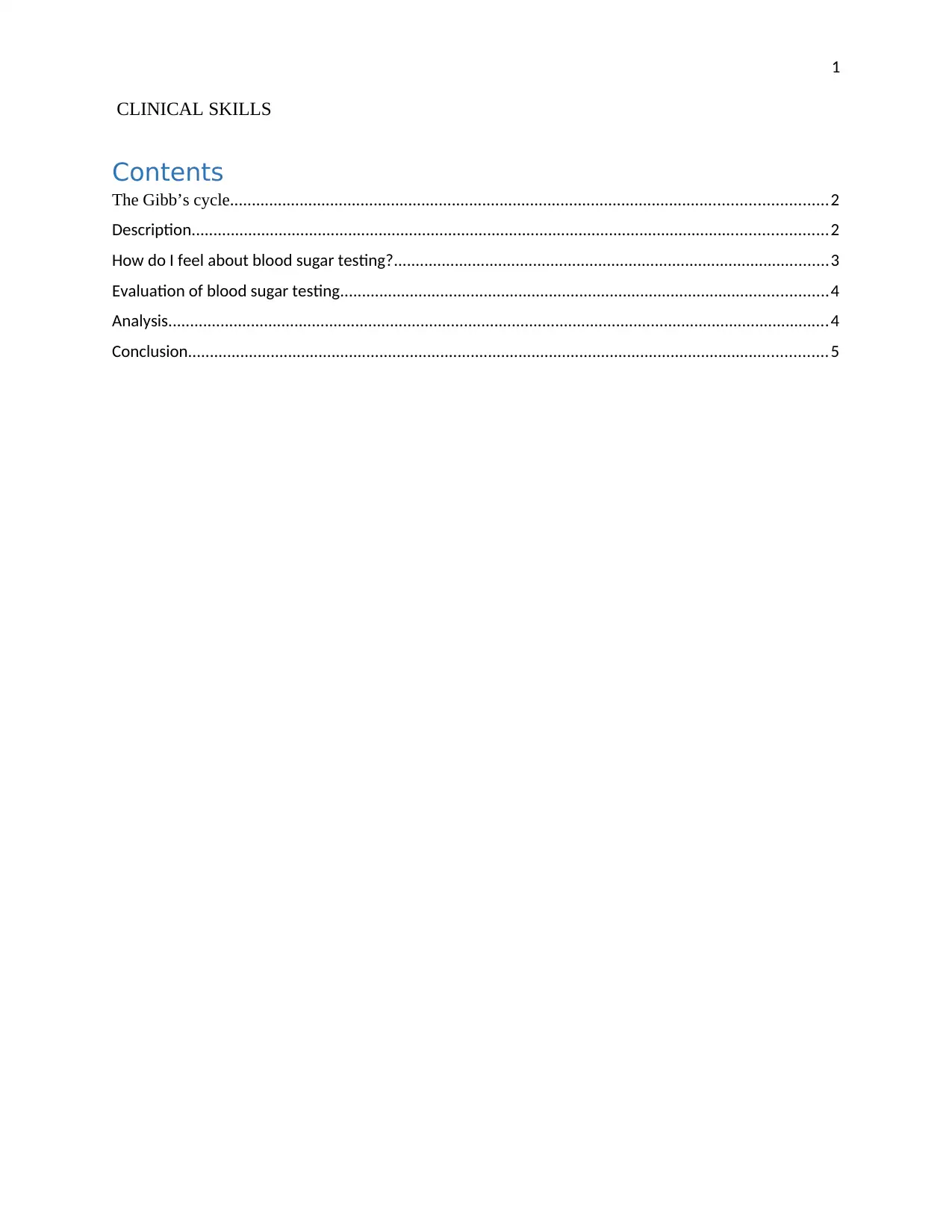
1
CLINICAL SKILLS
Contents
The Gibb’s cycle.........................................................................................................................................2
Description..................................................................................................................................................2
How do I feel about blood sugar testing?....................................................................................................3
Evaluation of blood sugar testing................................................................................................................4
Analysis........................................................................................................................................................4
Conclusion...................................................................................................................................................5
CLINICAL SKILLS
Contents
The Gibb’s cycle.........................................................................................................................................2
Description..................................................................................................................................................2
How do I feel about blood sugar testing?....................................................................................................3
Evaluation of blood sugar testing................................................................................................................4
Analysis........................................................................................................................................................4
Conclusion...................................................................................................................................................5
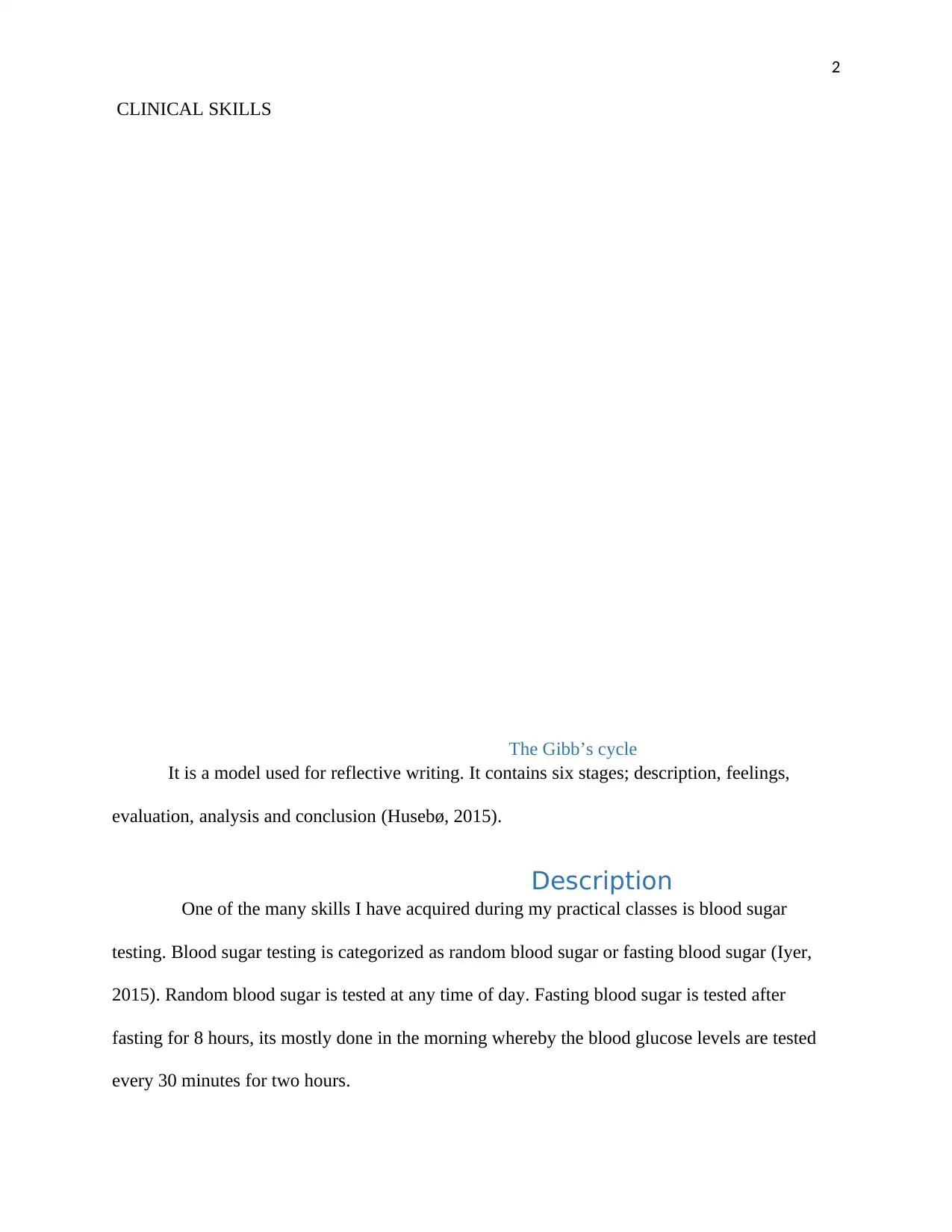
2
CLINICAL SKILLS
The Gibb’s cycle
It is a model used for reflective writing. It contains six stages; description, feelings,
evaluation, analysis and conclusion (Husebø, 2015).
Description
One of the many skills I have acquired during my practical classes is blood sugar
testing. Blood sugar testing is categorized as random blood sugar or fasting blood sugar (Iyer,
2015). Random blood sugar is tested at any time of day. Fasting blood sugar is tested after
fasting for 8 hours, its mostly done in the morning whereby the blood glucose levels are tested
every 30 minutes for two hours.
CLINICAL SKILLS
The Gibb’s cycle
It is a model used for reflective writing. It contains six stages; description, feelings,
evaluation, analysis and conclusion (Husebø, 2015).
Description
One of the many skills I have acquired during my practical classes is blood sugar
testing. Blood sugar testing is categorized as random blood sugar or fasting blood sugar (Iyer,
2015). Random blood sugar is tested at any time of day. Fasting blood sugar is tested after
fasting for 8 hours, its mostly done in the morning whereby the blood glucose levels are tested
every 30 minutes for two hours.
⊘ This is a preview!⊘
Do you want full access?
Subscribe today to unlock all pages.

Trusted by 1+ million students worldwide
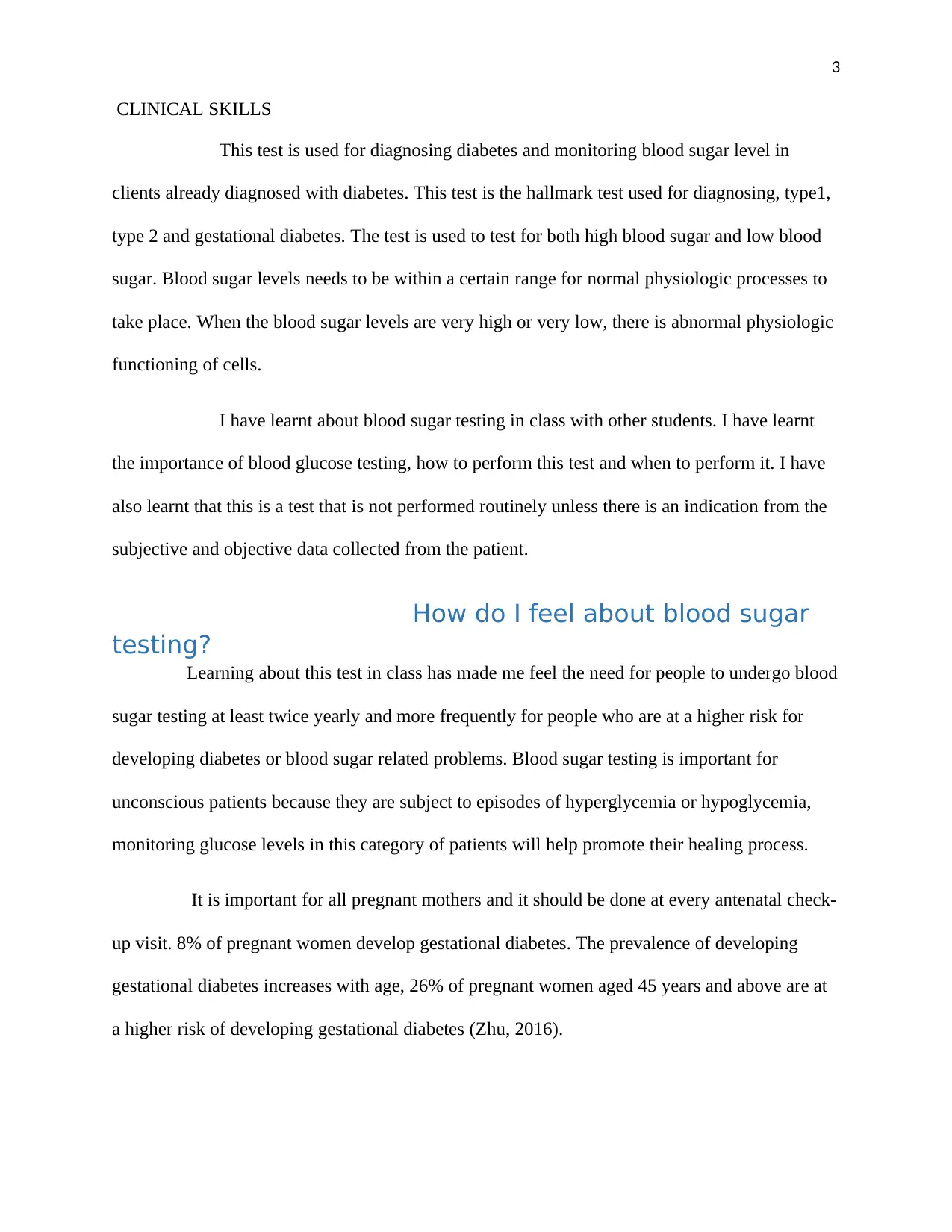
3
CLINICAL SKILLS
This test is used for diagnosing diabetes and monitoring blood sugar level in
clients already diagnosed with diabetes. This test is the hallmark test used for diagnosing, type1,
type 2 and gestational diabetes. The test is used to test for both high blood sugar and low blood
sugar. Blood sugar levels needs to be within a certain range for normal physiologic processes to
take place. When the blood sugar levels are very high or very low, there is abnormal physiologic
functioning of cells.
I have learnt about blood sugar testing in class with other students. I have learnt
the importance of blood glucose testing, how to perform this test and when to perform it. I have
also learnt that this is a test that is not performed routinely unless there is an indication from the
subjective and objective data collected from the patient.
How do I feel about blood sugar
testing?
Learning about this test in class has made me feel the need for people to undergo blood
sugar testing at least twice yearly and more frequently for people who are at a higher risk for
developing diabetes or blood sugar related problems. Blood sugar testing is important for
unconscious patients because they are subject to episodes of hyperglycemia or hypoglycemia,
monitoring glucose levels in this category of patients will help promote their healing process.
It is important for all pregnant mothers and it should be done at every antenatal check-
up visit. 8% of pregnant women develop gestational diabetes. The prevalence of developing
gestational diabetes increases with age, 26% of pregnant women aged 45 years and above are at
a higher risk of developing gestational diabetes (Zhu, 2016).
CLINICAL SKILLS
This test is used for diagnosing diabetes and monitoring blood sugar level in
clients already diagnosed with diabetes. This test is the hallmark test used for diagnosing, type1,
type 2 and gestational diabetes. The test is used to test for both high blood sugar and low blood
sugar. Blood sugar levels needs to be within a certain range for normal physiologic processes to
take place. When the blood sugar levels are very high or very low, there is abnormal physiologic
functioning of cells.
I have learnt about blood sugar testing in class with other students. I have learnt
the importance of blood glucose testing, how to perform this test and when to perform it. I have
also learnt that this is a test that is not performed routinely unless there is an indication from the
subjective and objective data collected from the patient.
How do I feel about blood sugar
testing?
Learning about this test in class has made me feel the need for people to undergo blood
sugar testing at least twice yearly and more frequently for people who are at a higher risk for
developing diabetes or blood sugar related problems. Blood sugar testing is important for
unconscious patients because they are subject to episodes of hyperglycemia or hypoglycemia,
monitoring glucose levels in this category of patients will help promote their healing process.
It is important for all pregnant mothers and it should be done at every antenatal check-
up visit. 8% of pregnant women develop gestational diabetes. The prevalence of developing
gestational diabetes increases with age, 26% of pregnant women aged 45 years and above are at
a higher risk of developing gestational diabetes (Zhu, 2016).
Paraphrase This Document
Need a fresh take? Get an instant paraphrase of this document with our AI Paraphraser
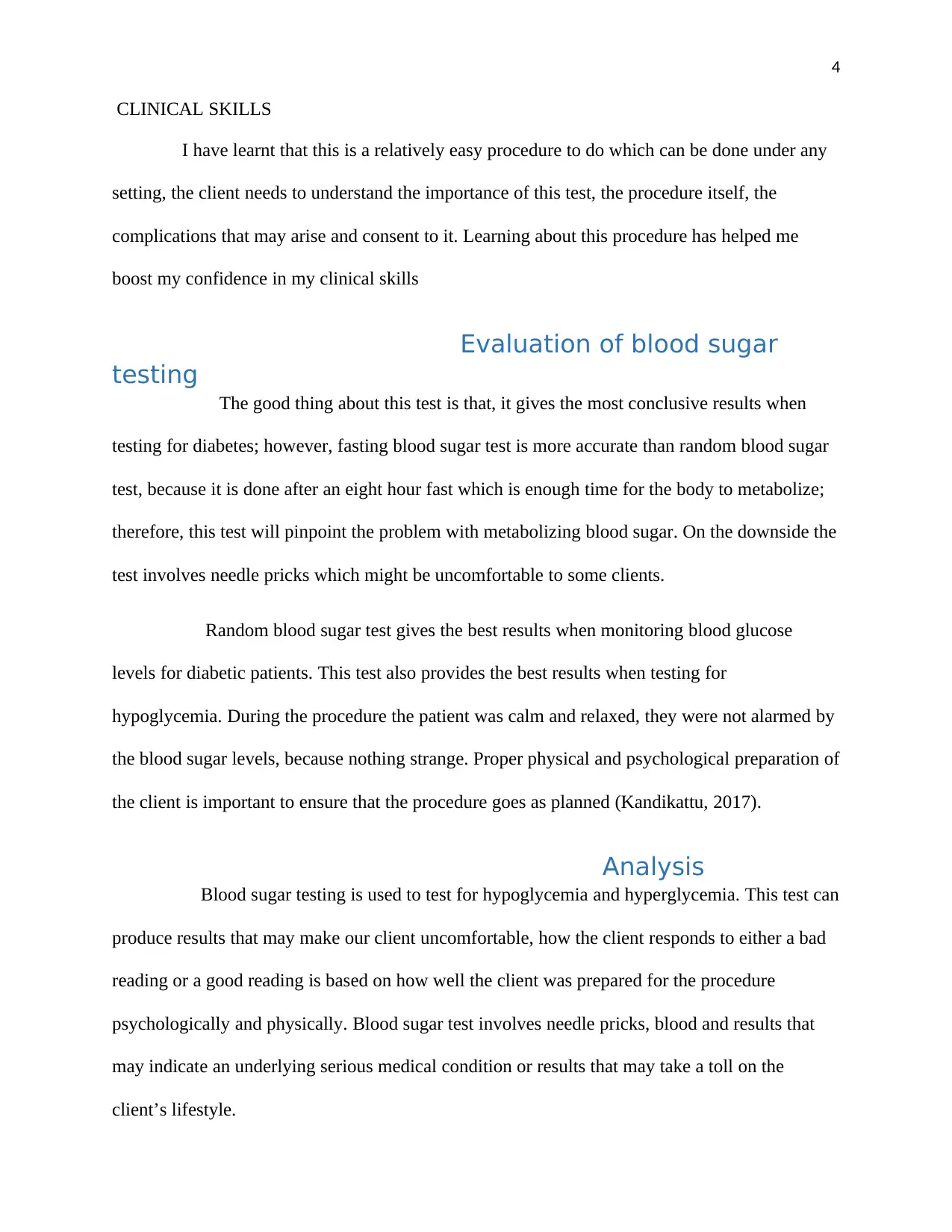
4
CLINICAL SKILLS
I have learnt that this is a relatively easy procedure to do which can be done under any
setting, the client needs to understand the importance of this test, the procedure itself, the
complications that may arise and consent to it. Learning about this procedure has helped me
boost my confidence in my clinical skills
Evaluation of blood sugar
testing
The good thing about this test is that, it gives the most conclusive results when
testing for diabetes; however, fasting blood sugar test is more accurate than random blood sugar
test, because it is done after an eight hour fast which is enough time for the body to metabolize;
therefore, this test will pinpoint the problem with metabolizing blood sugar. On the downside the
test involves needle pricks which might be uncomfortable to some clients.
Random blood sugar test gives the best results when monitoring blood glucose
levels for diabetic patients. This test also provides the best results when testing for
hypoglycemia. During the procedure the patient was calm and relaxed, they were not alarmed by
the blood sugar levels, because nothing strange. Proper physical and psychological preparation of
the client is important to ensure that the procedure goes as planned (Kandikattu, 2017).
Analysis
Blood sugar testing is used to test for hypoglycemia and hyperglycemia. This test can
produce results that may make our client uncomfortable, how the client responds to either a bad
reading or a good reading is based on how well the client was prepared for the procedure
psychologically and physically. Blood sugar test involves needle pricks, blood and results that
may indicate an underlying serious medical condition or results that may take a toll on the
client’s lifestyle.
CLINICAL SKILLS
I have learnt that this is a relatively easy procedure to do which can be done under any
setting, the client needs to understand the importance of this test, the procedure itself, the
complications that may arise and consent to it. Learning about this procedure has helped me
boost my confidence in my clinical skills
Evaluation of blood sugar
testing
The good thing about this test is that, it gives the most conclusive results when
testing for diabetes; however, fasting blood sugar test is more accurate than random blood sugar
test, because it is done after an eight hour fast which is enough time for the body to metabolize;
therefore, this test will pinpoint the problem with metabolizing blood sugar. On the downside the
test involves needle pricks which might be uncomfortable to some clients.
Random blood sugar test gives the best results when monitoring blood glucose
levels for diabetic patients. This test also provides the best results when testing for
hypoglycemia. During the procedure the patient was calm and relaxed, they were not alarmed by
the blood sugar levels, because nothing strange. Proper physical and psychological preparation of
the client is important to ensure that the procedure goes as planned (Kandikattu, 2017).
Analysis
Blood sugar testing is used to test for hypoglycemia and hyperglycemia. This test can
produce results that may make our client uncomfortable, how the client responds to either a bad
reading or a good reading is based on how well the client was prepared for the procedure
psychologically and physically. Blood sugar test involves needle pricks, blood and results that
may indicate an underlying serious medical condition or results that may take a toll on the
client’s lifestyle.
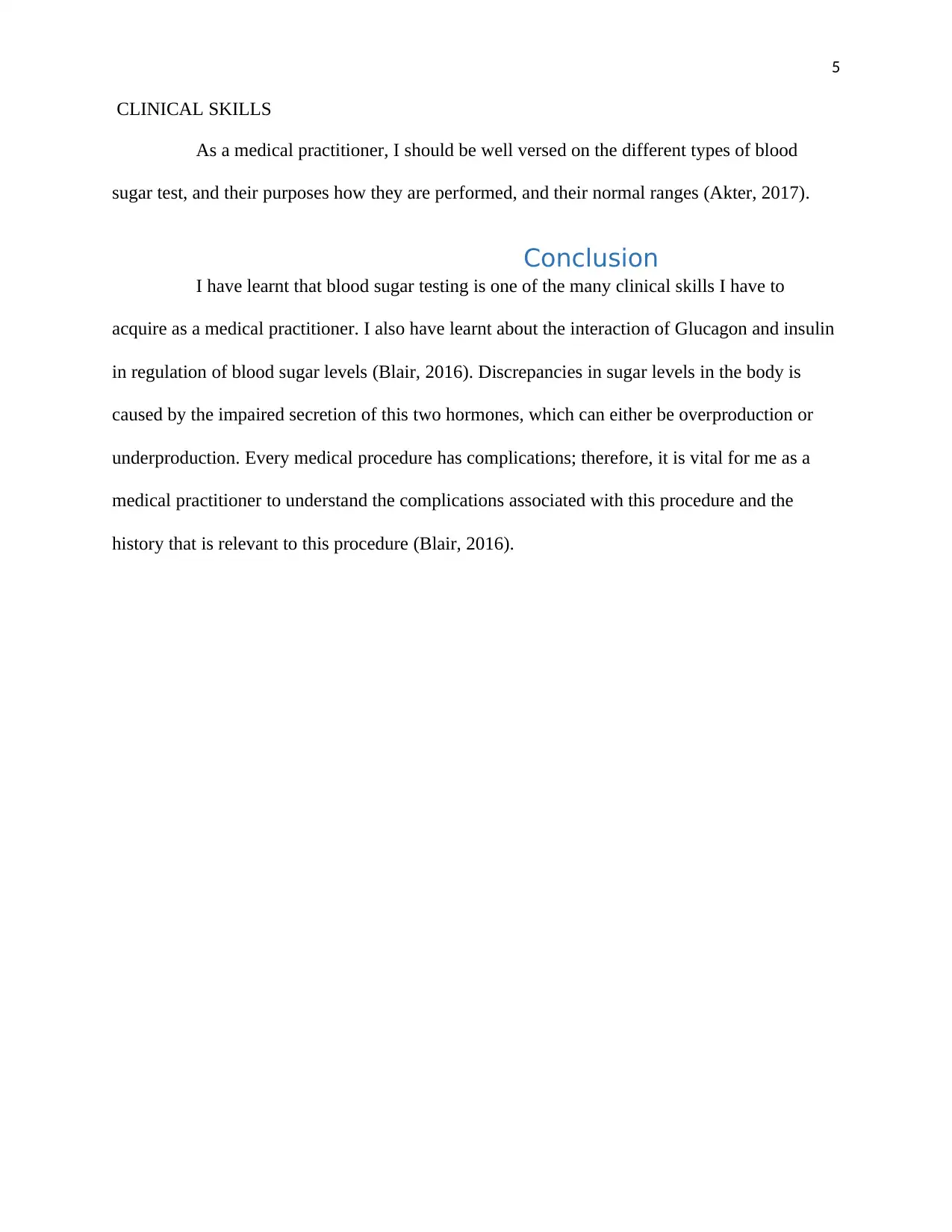
5
CLINICAL SKILLS
As a medical practitioner, I should be well versed on the different types of blood
sugar test, and their purposes how they are performed, and their normal ranges (Akter, 2017).
Conclusion
I have learnt that blood sugar testing is one of the many clinical skills I have to
acquire as a medical practitioner. I also have learnt about the interaction of Glucagon and insulin
in regulation of blood sugar levels (Blair, 2016). Discrepancies in sugar levels in the body is
caused by the impaired secretion of this two hormones, which can either be overproduction or
underproduction. Every medical procedure has complications; therefore, it is vital for me as a
medical practitioner to understand the complications associated with this procedure and the
history that is relevant to this procedure (Blair, 2016).
CLINICAL SKILLS
As a medical practitioner, I should be well versed on the different types of blood
sugar test, and their purposes how they are performed, and their normal ranges (Akter, 2017).
Conclusion
I have learnt that blood sugar testing is one of the many clinical skills I have to
acquire as a medical practitioner. I also have learnt about the interaction of Glucagon and insulin
in regulation of blood sugar levels (Blair, 2016). Discrepancies in sugar levels in the body is
caused by the impaired secretion of this two hormones, which can either be overproduction or
underproduction. Every medical procedure has complications; therefore, it is vital for me as a
medical practitioner to understand the complications associated with this procedure and the
history that is relevant to this procedure (Blair, 2016).
⊘ This is a preview!⊘
Do you want full access?
Subscribe today to unlock all pages.

Trusted by 1+ million students worldwide
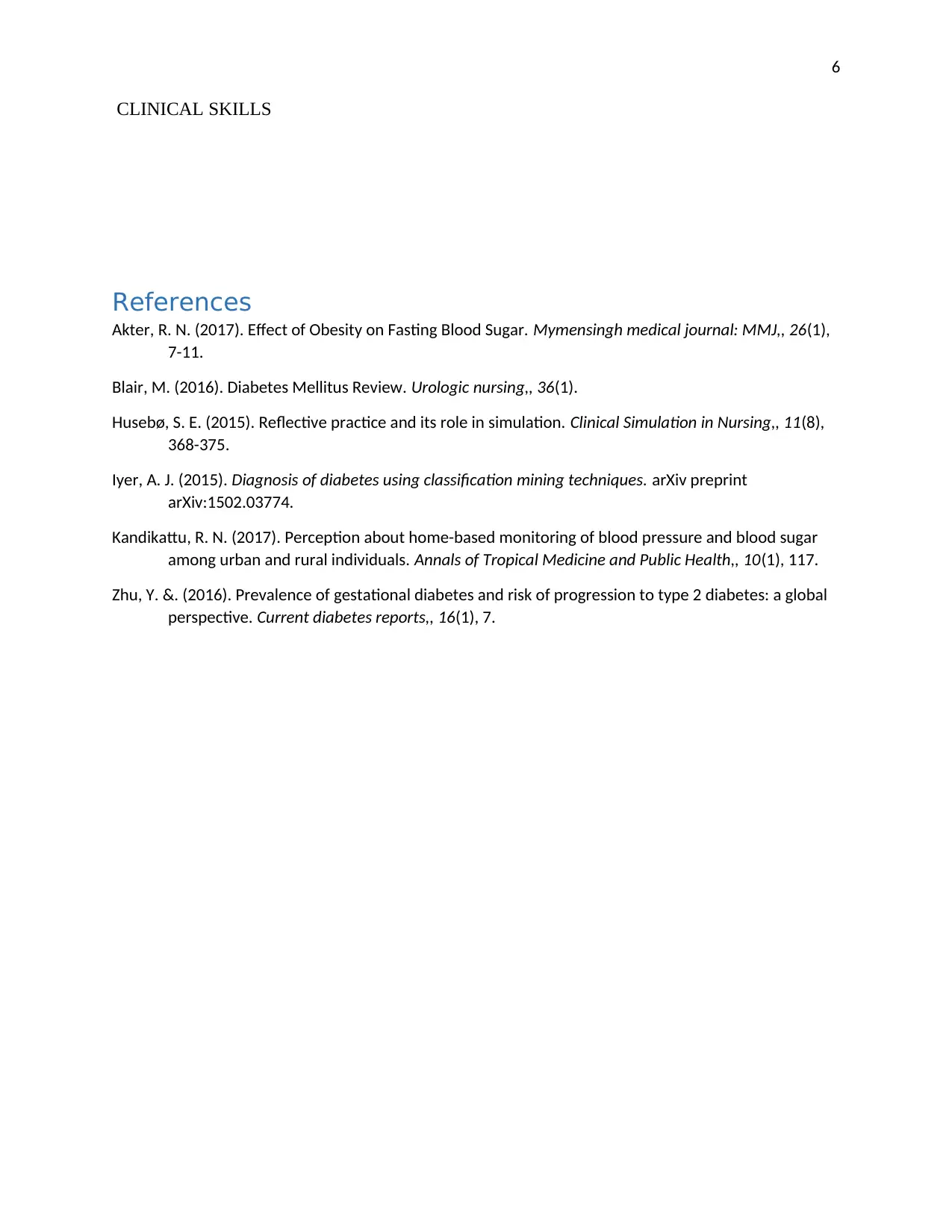
6
CLINICAL SKILLS
References
Akter, R. N. (2017). Effect of Obesity on Fasting Blood Sugar. Mymensingh medical journal: MMJ,, 26(1),
7-11.
Blair, M. (2016). Diabetes Mellitus Review. Urologic nursing,, 36(1).
Husebø, S. E. (2015). Reflective practice and its role in simulation. Clinical Simulation in Nursing,, 11(8),
368-375.
Iyer, A. J. (2015). Diagnosis of diabetes using classification mining techniques. arXiv preprint
arXiv:1502.03774.
Kandikattu, R. N. (2017). Perception about home-based monitoring of blood pressure and blood sugar
among urban and rural individuals. Annals of Tropical Medicine and Public Health,, 10(1), 117.
Zhu, Y. &. (2016). Prevalence of gestational diabetes and risk of progression to type 2 diabetes: a global
perspective. Current diabetes reports,, 16(1), 7.
CLINICAL SKILLS
References
Akter, R. N. (2017). Effect of Obesity on Fasting Blood Sugar. Mymensingh medical journal: MMJ,, 26(1),
7-11.
Blair, M. (2016). Diabetes Mellitus Review. Urologic nursing,, 36(1).
Husebø, S. E. (2015). Reflective practice and its role in simulation. Clinical Simulation in Nursing,, 11(8),
368-375.
Iyer, A. J. (2015). Diagnosis of diabetes using classification mining techniques. arXiv preprint
arXiv:1502.03774.
Kandikattu, R. N. (2017). Perception about home-based monitoring of blood pressure and blood sugar
among urban and rural individuals. Annals of Tropical Medicine and Public Health,, 10(1), 117.
Zhu, Y. &. (2016). Prevalence of gestational diabetes and risk of progression to type 2 diabetes: a global
perspective. Current diabetes reports,, 16(1), 7.
Paraphrase This Document
Need a fresh take? Get an instant paraphrase of this document with our AI Paraphraser
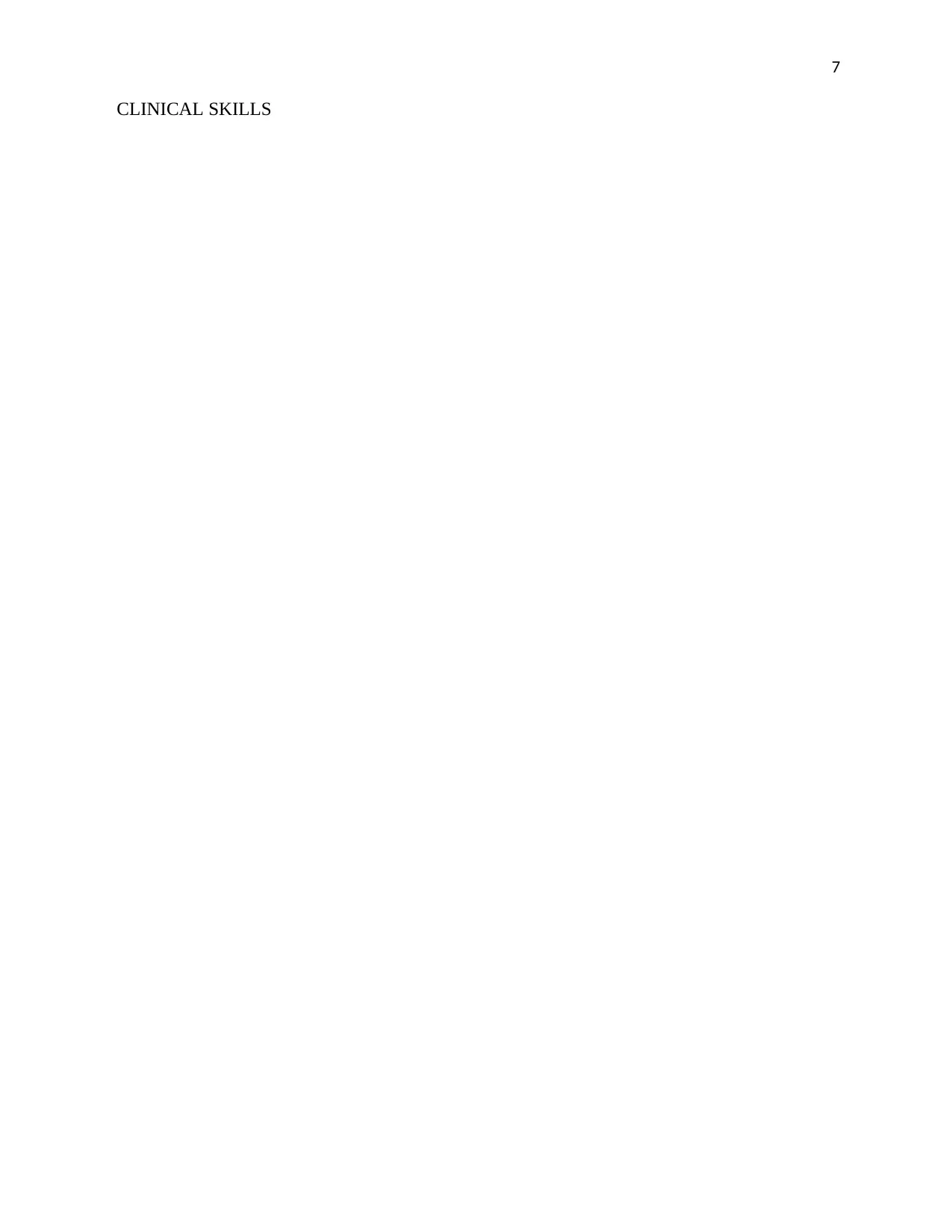
7
CLINICAL SKILLS
CLINICAL SKILLS
1 out of 8
Related Documents
Your All-in-One AI-Powered Toolkit for Academic Success.
+13062052269
info@desklib.com
Available 24*7 on WhatsApp / Email
![[object Object]](/_next/static/media/star-bottom.7253800d.svg)
Unlock your academic potential
Copyright © 2020–2025 A2Z Services. All Rights Reserved. Developed and managed by ZUCOL.





